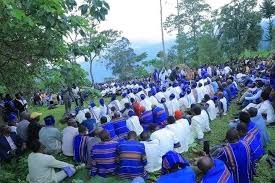
Before the corona virus pandemic and the Grand Ethiopian Renaissance Dam (GERD) absorbed all the public attention at home, the infestation of Lake Tana with water hyacinth, was a major public concern. It has been echoed for the past several years that Africa’s second and Ethiopia’s largest lake, the source of Abbay River (Blue Nile), has been crippled by an aquatic invasive alien ecologically devastating weed. And yet much attention is on the GERD unlike the ongoing grapple from its source of water.
Although numerous attempts have been made to eradicate the weed including the march of thousands of people to the lake as part of “Save Lake Tana” movement to remove the invasive weed by hand during the last years, the aggressive plant continues to come back. And the movement remained a onetime campaign.
This issue is also subjected to a present day fouls that expressing grave concern about a certain resource could be mistaken far beyond ones political spectrum. Unfortunately, the location of a particular resource tied with the socio-cultural presumption of those who discuss the matter could come under scrutiny at the nexus of a complex web of political and economic interests leaving no room for concerted effort.
When the water hyacinth infestation of Lake Tana hit the headlines, particularly in 2018, this writer went to the Addis Ababa University, College of Natural Sciences to learn about the plant from the renowned botanical scientist, Professor Sebsebe Demissew. Pooling some of his thick books the professor discussed the nature and danger of the plants that could put the aquatic biodiversity at extreme risk. Native to tropical and sub-tropical South America, water hyacinth, which goes by its scientific name “Eichhornia crassipes” is one of the most dangerous aquatic weeds. It is described as one of the fastest growing and free-floating perennial or hydrophyte plants which reproduces primarily by way of runners or stolons. It is also listed as one of the 100 most dangerous invasive species and the top 10 worst weeds in the world by the International Union for Conservation of Nature.
An Ethiopian Environment and Forest Research Institute study puts the characteristics of the plants with broad, thick, glossy, ovate leaves that may rise above the surface of the water as much as 1 meter in height and have 80cm root below the surface of water. The leaves are 10-20cm across, and float above the water surface. They have long, spongy and bulbous stalks. Each plant additionally can produce thousands of seeds each year and seeds can remain viable for more than 28 years. Some water hyacinths were found to grow up to 2 to 5 meters a day in some sites in Southeast Asia. The plants also doubles their population in two weeks.
The water hyacinth was officially reported in Ethiopia in 1950s in Aba Samuel Reservoir, and according to the aforementioned publication, the weed appeared at the Koka Reservoir and in the Awash River in 1965. Other infestations in the country include Gambela Region, the Blue Nile from just below Lake Tana into Sudan, and Lake Ellen near Alem Tena.
Lake Tana is used for transport, tourism, hydroelectric power generation and ecological conservation among others. It is home to 28 fish species, out of which 16 are endemic. In 2014, researchers have found out that about one-third of the lake’s shoreline, around 128km, was invaded by water hyacinth impacting both aquatic habitat health and local fishermen.
Amid repeated calls for swift effective control measures to be in place the water hyacinth keeps invading the lake, surrounding wetlands and tributary rivers. Researchers say this situation will dramatically impacts water flow, blocks sunlight from reaching native aquatic plants, and starves the water of oxygen, often killing fish (or other life in the water). An International Water Management Institute also reported the extraction of large volume of water from the lake has caused the water level to drop below the recommended level. If we put the GERD project aside for a while other hydroelectric powers (such as Chara Chara wier and the Tana Beles hydropower project) transportation and irrigation schemes will be definitely victims by the invasive weed.
Experts on the field are pessimistic about getting rid of a water hyacinth infestation easily. However like many other physical and social issues of the country this problem has been investigated by a number of researchers who come up with a range of recommendations how to rid of it. Dereje Tewabe, a researcher at Amhara Regional Agricultural Research Institute says the best method of controlling water hyacinth is to prevent it from being introduced in to a fresh water system.
Numerous other expert observations have indicated that the lake was highly exposed to contamination attributed to surface and underground discharge of wastes, degradation of its wetlands, siltation, upstream river damming and excessive withdrawal of its water for various purposes. Since the weed’s first official reporting in 2011 the farming practice on muddy soils near the edge of Lake Tana have contributed for the aggressive infestation of water hyacinth.
In his Preliminary Survey of Water Hyacinth in Lake Tana, Dereje suggested educating the public about the problems that occur from disposal of unwanted water garden or aquarium plants in to fresh water systems or by not properly cleaning boats, trailers, other water sports equipment, bait buckets, or fishing equipment to remove all plant material before moving the equipment to another fresh water system or with in the lake boundaries itself.
Experts have three common recommendations to deal with this weed namely, physical control or removal, chemical control or using herbicides and biological control methods. Chemical control being the most widely used and expensive method of the others it may also harm the environment. Therefore, they advise for removing the weed physically – either manually or using machines, which could help reduce coverage and slow its spread. Biological control methods on other hand have shown to be more effective where insects would be released to control water hyacinth. However, according to researchers, this needs multidisciplinary study prior to introduce exotic species to Lake Tana ecosystem that might cause for massive degradation of the resource.
Even though the COVID-19 pandemic is a major public attention, the federal and regional governments need to invigorate the fight against the weed that precipitate extensive environmental and economic disruptions. Nonprofit organizations like the Global Coalition for Lake Tana Restoration that was established by Ethiopian water professionals in the U.S. should also be making viable strategic interventions while the grappling with coronavirus continues by other institutions. Even during the onetime campaign significant amount of money has been mobilized from across the nation and abroad, therefore there is a need for proper financial reporting as to what has been collected as well as the status of a weed harvesting machine on duty.
Above all, Ethiopia has to learn from past mistakes of losing its great water resources such as Lake Haramaya, if not for invasive weeds. As long as effective control programs are not in place water hyacinth remains a major problem as it is also being spotted in other water bodies in the country. Likewise Rift Valley lakes of Ziway, Abijata, Chamo, Abaya, Hawassa, and Koka are among other water resources to have been highly contaminated by various manmade pollutants which raises critical questions towards management and response mechanism by government authorities and research institutions.





